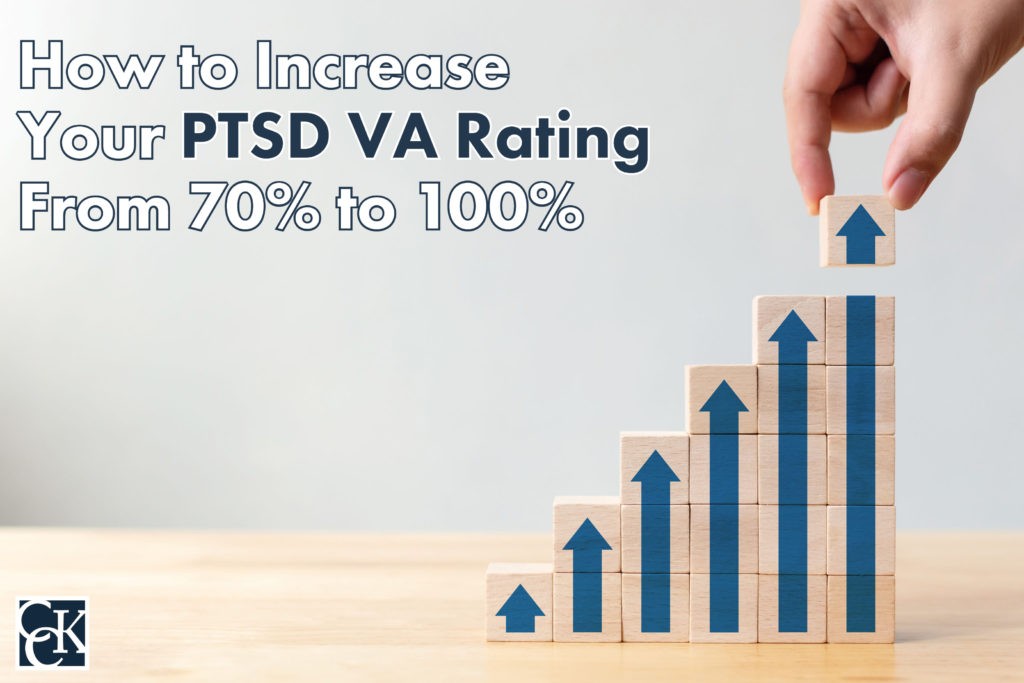How to Increase Your PTSD VA Rating From 70% to 100%

CCK Law: Our Vital Role in Veterans Law
Post-traumatic stress disorder (PTSD) is a very common condition among veterans. Symptoms of PTSD can often be debilitating and interfere with a veteran’s day-to-day life. The Department of Veterans Affairs (VA) offers disability benefits for veterans who developed PTSD as a result of their service. Continue reading to learn more about the different percentage rates for VA disability compensation for PTSD and the criteria needed to qualify for them.
What is Post-Traumatic Stress Disorder (PTSD)?
Post-traumatic stress disorder is a mental health condition that can affect people who have experienced or witnessed a traumatic event. This could be through a natural disaster, an accident, a terrorist attack, war or combat, sexual assault, or any other form of assault. Those who experience PTSD may have intense feelings or thoughts which can be disturbing and affect their life long after the trauma has ended. They may also experience flashbacks or nightmares, or feelings of great sadness, anger, or fear.
Symptoms of PTSD
- Intrusive Thoughts—Intrusive thoughts may occur in the form of repeated, involuntary memories, distressing dreams, or vivid flashbacks of the trauma.
- Avoidance—A person with PTSD may feel moved to avoid people, places, activities, or situations that could remind them of the trauma they experienced. Those who experience PTSD may want to avoid anything that could trigger memories regarding their trauma.
- Negative thoughts and feelings—PTSD can cause a person to feel overwhelmed with negative emotions or beliefs about oneself. A person with PTSD could feel perpetual fear, horror, anger, guilt, or shame. They may feel detached from others and lose interest in activities they previously enjoyed.
- Arousal and reactive symptoms—Those with PTSD could experience irritability and angry outbursts. They may also behave in a reckless or self-destructive way, could be easily started, and may have difficulty concentrating or sleeping.
It is also common that PTSD can take years to manifest. This means that veterans who experience PTSD may not display symptoms for years after their trauma.

Common Stressors for Veterans with PTSD
A stressor is another word for the trauma which can cause post-traumatic stress disorder or PTSD. For veterans, stressors could relate to exposure to danger, an injury, or an assault. Generally, VA categorizes stressors as combat-related or non-combat-related. Below are some examples of both types of PTSD stressors.
Combat PTSD Stressors
- Experiencing an IED explosion
- Witnessing a fellow service member become injured or killed
- Being part of a burial crew
- Experiencing an injury as a result of combat
- Experiencing mortar fire, small arms fire, or sniper fire
Non-Combat PTSD Stressors
- Being assaulted during service
- Threats of assault during service
- Military sexual trauma
- Threats of military sexual trauma
- Injuries sustained from accidents, such as a car accident
- Injuries sustained during training
VA Rating Criteria for PTSD
With the exception of eating disorders, VA regulates all mental health conditions on the same criteria. Mental health conditions may be rated at 0, 10, 30, 50, 70, or 100 percent under VA’s General Rating Formula for Mental Disorders (38 CFR § 4.130). The requirements for service connection at each rating level are listed below.
- 100% – total occupational and social impairment, due to such symptoms as:
- gross impairment in thought processes or communication; persistent delusions or hallucinations; grossly inappropriate behavior; persistent danger of hurting self or others; intermittent inability to perform activities of daily living (including maintenance of personal hygiene); disorientation to time or place; memory loss for names of close relatives, own occupation, or own name
- 70% – occupational and social impairment, with deficiencies in most areas, such as work, school, family relations, judgment, thinking, or mood, due to such symptoms as:
- suicidal ideation; obsessional rituals which interfere with routine activities; speech intermittently illogical, obscure, or irrelevant; near-continuous panic or depression affecting the ability to function independently, appropriately and effectively; impaired impulse control; spatial disorientation; neglect of personal appearance and hygiene; difficulty in adapting to stressful circumstances (including work or a work-like setting); inability to establish and maintain effective relationships
- 50% – occupational and social impairment with reduced reliability and productivity due to such symptoms as:
- flattened affect, circumstantial, circumlocutory, or stereotyped speech; panic attacks more than once a week; difficulty in understanding complex commands; impairment of short- and long-term memory; impaired judgment; impaired abstract thinking; disturbances of motivation and mood; difficulty in establishing and maintaining effective work and social relationships
- 30% – occupational and social impairment with occasional decrease in work efficiency and intermittent periods of inability to perform occupational tasks (although generally functioning satisfactorily, with routine behavior, self-care, and conversation normal), due to such symptoms as:
- depressed mood, anxiety, suspiciousness, panic attacks (weekly or less often), chronic sleep impairment, mild memory loss (such as forgetting names, directions, recent events)
- 10% – occupational and social impairment due to mild or transient symptoms which decrease work efficiency and ability to perform occupational tasks only during periods of significant stress, or symptoms controlled by continuous medication
- 0% – a mental condition has been formally diagnosed, but symptoms are not severe enough either to interfere with occupational and social functioning or to require continuous medication
Getting an Increased VA Rating for PTSD
If a veteran receives a decision and feels that they have been rated too low, they may submit a claim for an increased rating. Veterans may submit additional evidence to bolster their claim.
There are two ways to file a claim for an increased rating for PTSD. If the veteran is within the appeal window for a decision, meaning within one year of the date of a rating assignment, then they may file an appeal of the decision which will keep the claim open and pending. If the veteran is not within the appeal window, they may file a new claim for an increased rating.
TDIU and PTSD: Increasing a 70% PTSD Rating to 100%
Another option to secure an increased rating is by filing for TDIU, or total disability based on individual unemployability. If a veteran can prove that their PTSD prevents them from working, they may qualify for TDIU. TDIU allows a veteran to be compensated at the 100 percent rating level without having a 100 percent combined rating. Sometimes securing a higher rating can be difficult, so TDIU is a benefit that can be beneficial for veterans looking to secure the benefits of the 100 percent rating level.
The schedular requirements for Individual Unemployability are as follows:
- The veteran has one service-connected disability rated at least 60 percent disabling; OR
- The veteran has more than one service-connected disability, with one condition rated at least 40 percent, and a combined rating of at least 70 percent.
Medical evidence can be useful to submit to VA in order to support a claim for TDIU. This could include any records that indicate that the veteran’s PTSD was under-evaluated. Records which show that the veteran’s PTSD inhibits their ability to work and that their symptoms do meet the criteria of a higher rating can be helpful. Private medical opinions can also indicate this to VA.
Helpful Tips for Securing a PTSD VA Rating Increase
- Attend Your Compensation and Pension (C&P) Exam for PTSD—In order to be granted an increase, it is extremely important to attend all C&P exams that VA requests. VA may deny a veteran’s claim if they fail to attend a scheduled exam. If a veteran is unable to attend an exam, they should inform VA as soon as possible. If a veteran accidentally misses an exam, they should be sure to contact VA to try to reschedule.
- Use Lay Statements—Lay statements, or Statements in Support of the Claim, can be very useful as evidence that the veteran is eligible for an increased rating. With a lay statement, the veteran can attest to the symptoms they experience on a regular basis, how severe those symptoms are, and how they may hinder the veteran’s ability to function in social and occupational settings. Statements from people who are familiar with the veteran’s situation can also help indicate to VA how their PTSD inhibits their daily life.
- Highlight Your Symptoms—Many times, VA will deny an increased rating because a veteran does not have every single symptom that is listed for a particular rating on the scale. While each of the ratings has an extensive list of symptoms associated with it, this list is by no means exhaustive.
- The symptoms included in the list are meant to be examples, however, and serve as a guideline for the symptoms, severity, and frequency associated with a particular rating. A veteran does not need to have every symptom listed in order to qualify for that rating. If a veteran is denied because of this, they can certainly point out to VA that they do not need to have every symptom in order to be eligible. When composing lay statements, veterans may wish to highlight specific symptoms so VA can clearly see that the veteran does experience a level of impairment that qualifies them for that rating.
Filing for Secondary Service Connection
PTSD can cause other conditions to develop. A common example of this is a veteran developing sleep apnea on account of their PTSD. If a veteran does have a condition which they believe was either caused or aggravated by their service-connected PTSD, they may wish to file for secondary service connection. Secondary service connection can help increase the veteran’s overall combined rating, which can be beneficial in instances where the veteran might be having difficulty proving they meet the qualifications for an increased rating.
Examples of Conditions Secondary to PTSD
- Sleep Apnea
- Hypertension
- Gastroesophageal reflux disease (GERD)
- Irritable Bowel Syndrome (IBS)
- Migraines
- Erectile Dysfunction
Getting Help with an Appeal for an Increased Rating for PTSD
Sometimes veterans may need help with their appeal for an increased rating. Accredited representatives or attorneys can help veterans appeal for an increased rating.
If you need assistance appealing for an increased rating, the Veterans’ Law team at Chisholm Chisholm & Kilpatrick LTD has years of experience fighting denials and low rating assignments and may be able to assist you with your VA appeal. Call us today for a free consultation at 800-544-9144.
About the Author
Share this Post
